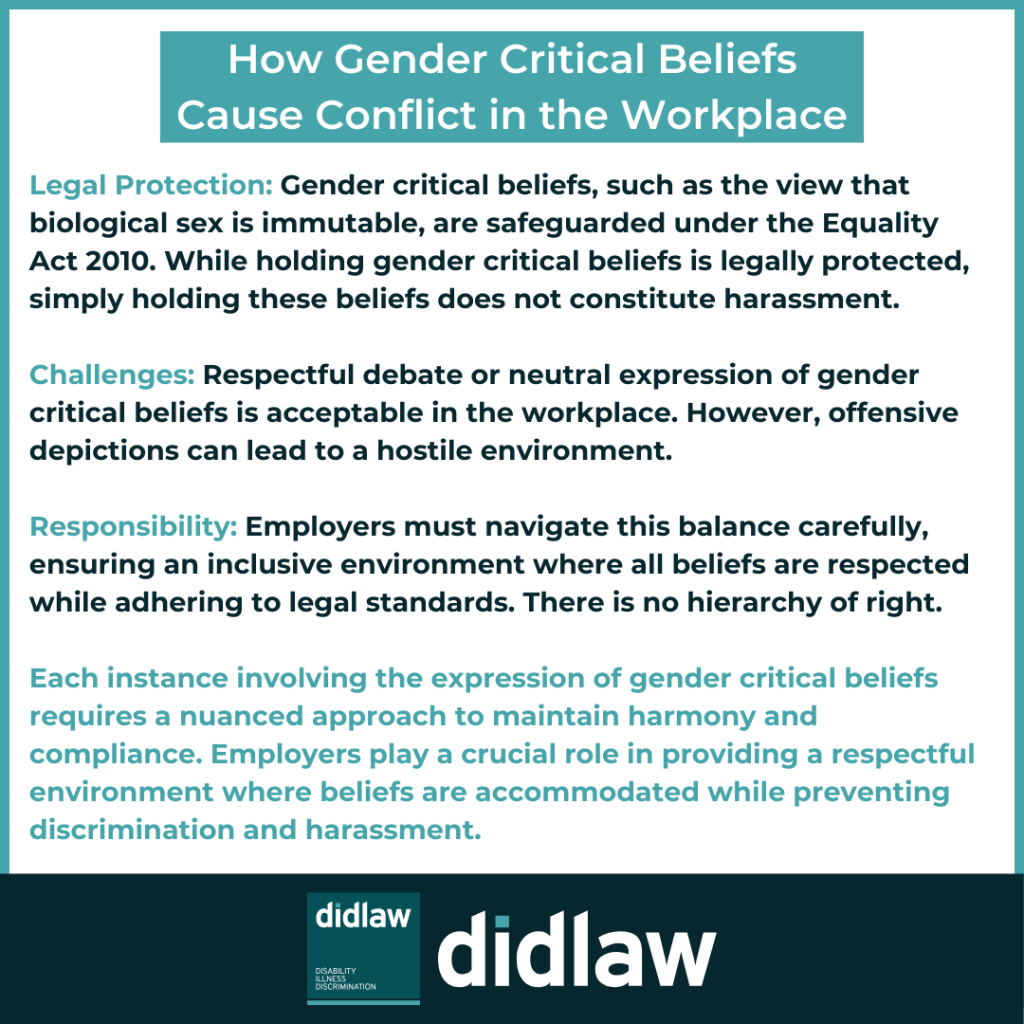
It is well established, thanks to the case of Forstater v CDG, that freedom to hold gender critical beliefs is protected under section 10(2) Equality Act 2010. That is the belief that biological sex is real, immutable and cannot be changed. The very issue of holding a gender critical belief has been the subject of much case law of late and we have seen a raft of claims where employees have successfully brought proceedings in respect of discrimination suffered because they hold and manifest those beliefs in the workplace.
What is tricky with all of these cases, and the law surrounding such beliefs is their manifestation, that is to say the articulation of those beliefs and how this may impact others. Employers need to be mindful of balancing beliefs and protected characteristics within the workplace. This is why we need to consider the qualification of the right to hold a belief and how it is manifested.
The right and associated protection to hold the belief arises under section 10 of the Equality Act 2010 but that right is qualified by Article 9 of the European Convention on Human Rights (the Convention) which deals with freedom of thought. The freedom to manifest a belief is subject only to those limitations as prescribed by law, as necessary in a democratic society or in the interests of public safety.
In addition, Article 10 of the Convention states that the exercise of freedom of expression is subject to those conditions/formalities as prescribed by law and as necessary in a democratic society. Section 3 of the Human Rights Act 1998 puts into effect that legislation must be read and given effect in a way which is compliant with Convention rights.
So where is the balance and how do we practically manage the right to hold a belief and the qualification of its articulation? I am of course looking at this in a workplace context as this is my area of expertise. Much has been made of the fact that merely holding gender critical beliefs (being the focus of this blog) is an automatic act of harassment against colleagues, that is even without the manifestation. This is simply incorrect. It is not the intention of the legislation, nor the outcome of the many recent cases, that the holding of such a belief (controversial as it may be) is sufficient to be an act of harassment (i.e. to cause offence or create a hostile working environment). I do not believe you can harass someone without manifestation and, it is the legal test under section 26 of the Equality 2010 which will determine if the manifestation of a belief qualifies as harassment.
Articulating the belief itself or being known to hold the belief is not going to be sufficient to meet the harassment threshold. Any manifestation of a belief can only be curtailed, under Articles 9 and 10 if prescribed by law or as necessary in a democratic society. This then leads me to consider where a manifestation can be problematic.
Respectful debate within the workplace or an objective/neutral articulation of a belief system is acceptable. It is when a belief which when articulated causes offence to another (by virtue of the harassment definition and where it is reasonable for that articulation to be considered offensive) that problems arise. Easier examples come from the manifestation of some fundamental Christian beliefs where individuals may believe that homosexuality is wrong, or a sin. Clearly, in a democratic society, and within a workplace in the UK, it is easy to assume that this would cause offence.
We have to take this issue holistically, and on a case-by-case basis. An employer must be mindful of the protection of beliefs under section 10 of the Equality Act 2010 and balance that against Articles 9 and 10 of the Convention in terms of qualification and limitation. The onus is on the employer to create an inclusive environment where all protected characteristics are respected and where all efforts are made to obtain a balancing of rights. There is no hierarchy of rights and the very nature of the human condition is that everyone is different and everyone will have an opinion.
This blog was written by Elizabeth McGlone, Partner at didlaw
